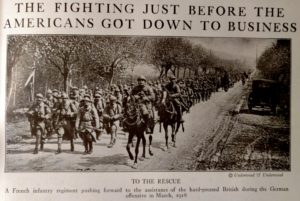 Through the eyes of a German Staff Officer. Excerpt from Battle of the Meuse Argonne from the German Perspective (Silver Spring: Dale Street Books, 1917), reproduction of original articles published in the Infantry Journal in 1921.
Through the eyes of a German Staff Officer. Excerpt from Battle of the Meuse Argonne from the German Perspective (Silver Spring: Dale Street Books, 1917), reproduction of original articles published in the Infantry Journal in 1921.
THE FIRST AMERICAN ASSAULT SEPTEMBER 26
Although the French attack west of the Argonne in no way surprised the German command, the Americans had succeeded in cleverly concealing their preparations for attack and in establishing a homogeneous American front of nine divisions during the night of September 25, in the place of the mixed French-American troops between the Argonne and the Meuse. These divisions were, from west to east, the 77th, 28th, 35th, 91st, 37th, 79th, 4th, 80th, and 33d, divided among three Corps Headquarters, the 1st, 5th, and 3d. Of these divisions, the 77th, 28th, 35th, 4th, and 33d had had experience in battle, the 37th and 80th had until then been engaged on a quiet front only, while the 91st and 79th were in the fighting line for the first time. All the divisions were well rested, fresh, and in thoroughly good fighting condition. Their nourishment, morale, and equipment were excellent. The effective strength of the companies was 225-250 men on an average. Artillery, aviation, and tanks were available in abundance.
Shortly after 11 o’clock of the night of September 25, a strong enemy artillery fire was opened on the whole front from west of the Argonne to the Meuse. At first, only a harassing fire was directed on the Argonne. Many gas shells were used. The long-range fire reached far into the back areas. The hum of aeroplanes and the sound of explosions were reported near Vauquois. The German telephone lines, meteorological stations, and survey and signal posts were put out of action.
The effect of the German counter-batteries was limited, as the front east of the Argonne was but sparsely provided with reinforcing artillery.
At 2 o’clock in the morning of the 26th of September the enemy’s fire, which in the meantime had died down, was renewed with full force, and the American Infantry came into the attack at 5 o’clock on the same morning.
Their blow fell chiefly on the 1st Guards, whose position lay east of the Argonne, and the adjacent 117th Infantry and 7th Reserve Divisions, while, at the same time, east of the Meuse, French troops (10th Colonial Division) made a demonstrative push on Dieppe. East of the Meuse, the enemy’s fire fell in varying intensity in the environs of Beaumont, while harassing fire only was dropped further east.
The attack of the American Infantry was greatly favored by a thick mist, which remained until late in the morning.
The 77th and 28th American Divisions in the Argonne did not make a serious attack and, on the day of the attack, won only an insignificant amount of terrain, which was, for the most part, voluntarily ceded by the 2d Landwehr Division. The left flank of the 1st Guards Division was at first quickly flattened out, and the entire division then forced back against the eastern edge of the Argonne. Varennes and Cheppy were lost. During the evening, the enemy pushed through as far as Baulny, but was driven out by the 4th Guards Regiment. Eighteen tanks, disabled by fire, remained stranded near Charpentry alone. In the evening, the 1st Guards Division, which had suffered extremely heavily, held the line running approximately through Argonne-Charpentry-Epinonville.
There was a wide gap left open in the valley of the Aire. No reserves were available, as only one regiment from the 5th Guards Division (Infantry Regiment No. 20) had arrived, and had already taken up a position near Exermont.
The 117th and 7th Reserve Divisions, too, had been overrun and flung back towards the north. The former still managed to hold Montfaucon, which formed the point of a salient, but the line of defense fell back again to approximately the Epinonville-Nantillois line and north of the wooded terrain of Septsarges and Dannevoux to the Meuse. Here further advance on the part of the enemy was prevented by the 5th Bavarian Reserve Division, which was moving in an easterly direction toward Nantillois.
The Americans had won a belt of terrain from about 4 to 9 kilometers deep on a front of about 20 kilometers.
SEPTEMBER 27
After a comparatively quiet night, the enemy, again favored by mist, and supported by an extremely large number of tanks, renewed his attacks. This time he also attacked west of the Argonne in the direction of Cernay, but was repulsed by the troops of the 9th Landwehr Division. There was little heavy fighting in the Argonne on this day. Heavy fighting developed again between the wooded hills and the Meuse. Meanwhile, on the Montblainville-Epinonville front, the whole of the 5th Guards Division had been pushed in between the thin ranks of the 1st Guards Division. The main attack, supported by tanks, was launched on both sides of the valley of the Aire against Montblainville and Charpentry. Both of these places, which were defended by Landwehr Troops and the 3d Guards regiment, were lost. The enemy pushed up to Baulny, and, further east, crossed the main road running in a northeasterly direction from Charpentry. The counter attacks of the 4th Guards and 20th Infantry Regiments produced a temporary relief of the tension, but were unable to prevent the enemy, late in the evening, and supported by large numbers of tanks, from taking the heights north of Baulny. As in the valley of the Aire, on September 26, the situation east of the Aire for the Germans, who had no further reserves whatever available, was extremely critical.
* * * * * *
